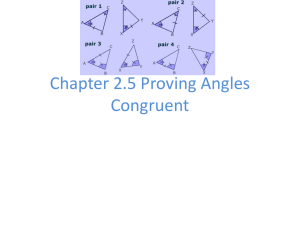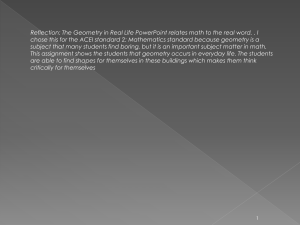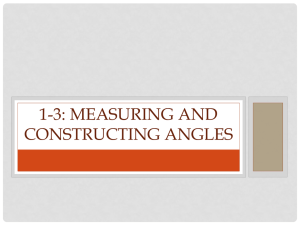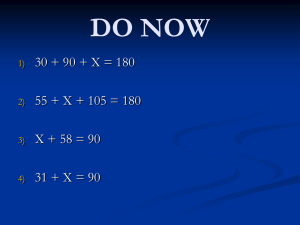Chapter 5 Notes and Examples
advertisement
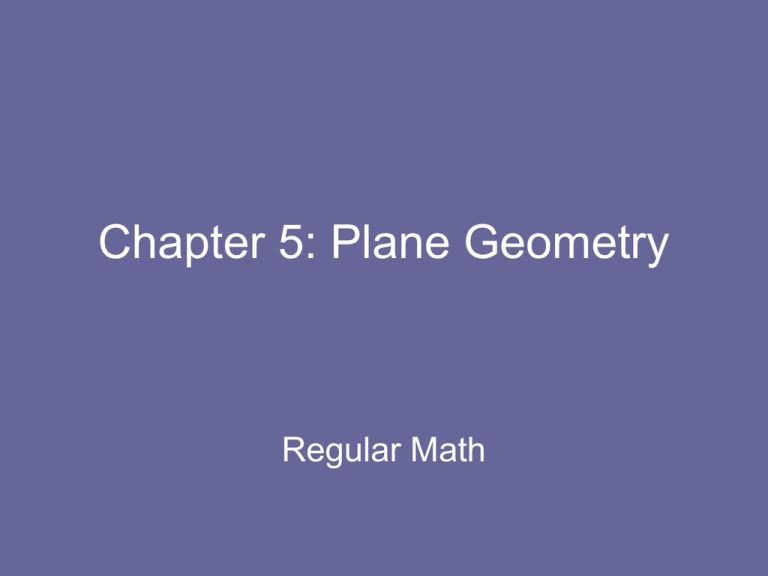
Chapter 5: Plane Geometry Regular Math Section 5.1: Points, Lines, Planes, and Angles • A point names a location. • A line is perfectly straight and extends forever in both directions. • A plane is a perfectly flat surface that extends forever in all directions. • A segment, or line segment, is the part of a line between two points. • A ray is part of a line that starts at one point and extends forever in one direction. Naming Points, Lines, Planes, Segments, and Rays • Name 4 points. • Name a line. • Name a plane. • Name 4 segments. • Name 4 rays. Classifying Angles Vocabulary • Complementary Angles have measures that add up to 90 degrees. • Supplementary Angles have measures that add to 180 degrees. • Right Angles measure 90 degrees. • Acute Angles measure less than 90 degrees. • Obtuse Angles measure more than 90 degrees but less that 180 degrees. • Straight Angles measure exactly 180 degrees. Classifying Angles • Name a right angle. • Name two acute angles. • Name two obtuse angles. • Name a pair of complementary angles. • Name a pair of supplementary angles. Try these on your own… 1. Name a point. 2. Name a line. 3. Name a segment. 4. Name a ray. 5. Name a right angle. 6. Name an acute angle. 7. Name a obtuse angle. 8. Name a pair of complementary angles. 9. Name a pair of supplementary angles. Vertical Angles Vocabulary • Intersecting lines form two pairs of vertical angles. Vertical Angles • <1 and <3 are vertical angles, and <2 and <4 are vertical angles. 1. If m<2 = 30 degrees, find m<4? 2. If m<1 = 150 degrees, find m<3? Section 5.2: Parallel and Perpendicular Lines • Parallel Lines are two lines in a plane that never meet, like train tracks. • Perpendicular Lines are two lines that intersect at a 90 degree angle. • A Transversal is a line that intersects any two or more lines. Identifying Congruent Angles Formed by a Transversal • Measure the angles formed by the transversal and the parallel lines. What angles seem to be congruent? <4 and <2 <1 and <3 <8 and <6 <7 and <5 4 2 8 6 1 3 7 5 Try this one on your own… • Measure the angles formed by the transversal and the parallel lines. Which angles seem to be congruent? 1 3 5 7 4 2 8 6 Finding Angle Measures of Parallel Lines Cut by Transversals • In the figure, line m and line n are parallel. Find the measure of each angle? <1 = 117 <2 = 63 <3 = 117 <4 =63 <5 = 117 <6 = 63 <7 = 117 Try this one on your own… • In the figure, line g is parallel to line h. Find the measure of each angle? <1 = 161 <2 = 19 <3 = 19 <4 = 161 <5 = 161 <6 = 19 <7 = 19 Section 5.3: Triangles Triangle Vocabulary • An equilateral triangle has 3 congruent sides and 3 congruent angles. • An isosceles triangle has at least 2 congruent sides and 2 congruent angles. • A scalene triangle has no congruent sides and no congruent angles. Finding Angles in a Triangle That Meets Given Conditions • 1st angle = x • The second angle in a • 2nd angle = 2x triangle is twice as • 3rd angle = ½ (2x) large as the first. The third angle is half as x + 2x + ½(2x) = 180 large as the second. x + 2x + x = 180 Find the angle measures and draw a 4x = 180 possible picture. 4x = 180 4 4 x = 45 degrees Section 5.4: Polygons Polygon Vocabulary • A polygon is a closed plane figure formed by three or more sides. • All the sides and angles of a regular polygon have equal measures. Finding Sums of the Angle Measures in Polygons Find the sum of the angle measures in a pentagon. • Step One: Divide the figure into triangles. • Step Two: Multiply the # of triangles and 180 degrees. Try this one on your own… • Find the sum of the angle measures in a hexagon. • 4 Triangles • 4 x 180 = 720 • In a polygon, there are 2 more sides than triangles. • An n-gon can be divided into n-2 triangles. • The sum of the angle measures of any n-gon is 180 (N – 2). Formula N (X) = 180 (N – 2) N = NUMBER OF SIDES Finding the Measure of Each Angle in a Regular Polygon • Find the angle measure in each regular polygon. Step One: Figure out how many sides the figure has… 5 Step Two: Fill the number of sides into the equation. 5x = 180 (5 – 2) Step Three: Solve 5x = 180 (5 – 2) 5x = 180 (3) 5x = 540 5x = 540 5 5 x = 108 degrees Try this one on your own… • Number of Sides: 4 4x = 180 (4 -2 ) 4x = 180 (2) 4x = 360 4x = 360 4 4 X = 90 degrees Find the angle measure in each regular polygon? Classifying Polygons • Give all the names that apply to each figure. – Quadrilateral – Parallelogram – Rhombus Try this one on your own… • Give all the names that apply to each figure. – Quadrilateral – Trapezoid Section 5.6: Congruence • A correspondence is a way of matching up two sets of objects. Writing Congruence Statements Write a congruence statement for each pair of polygons. <G is equal to <L <H is equal to <J <F is equal to <K Triangle GHF is congruent to Triangle LJK • Write a congruence statement for each pair of polygons. Quadrilateral DABC is congruent to Quadrilateral MLKN. Try this one on your own… Quadrilateral HEFG is congruent to Quadrilateral LMNK Using Congruence Relationships to Find Unknown Values • In the figure, hexagon PQRSTU is congruent to hexagon ABCDEF. Find the value of w. Step One: Figure out what angle corresponds with the angle you are trying to find. . <B Step Two: Set up an equation. <Q = <B 2w = 158 Step Three: Solve 2w = 158 2w = 158 2 2 w = 79 • In the figure, quadrilateral ABCD is congruent to quadrilateral GJIH. • Find x. • Step One: Figure out which side is congruent to side with the variable. AD is congruent to GH. • Step Two: Set up an equation. X/3=9 • Step Three: Solve x/3=9 3 ( x / 3) = 9 x = 27 Try these on your own… • Find b. • (b-14) = 84 • b = 98 • Find a. • a = 10 • In the figure, quadrilateral RSTU is congruent to quadrilateral HIFG.


